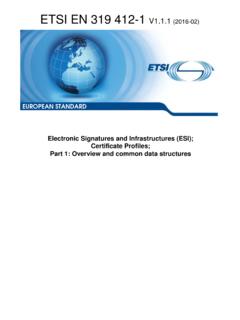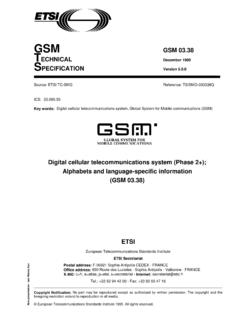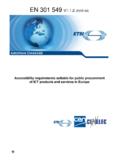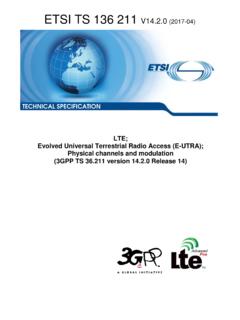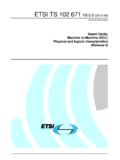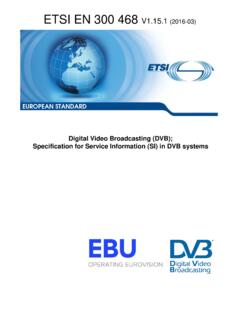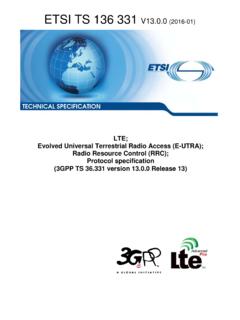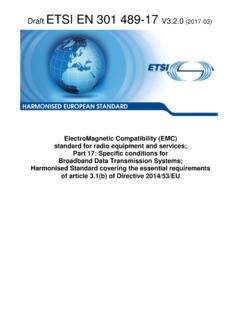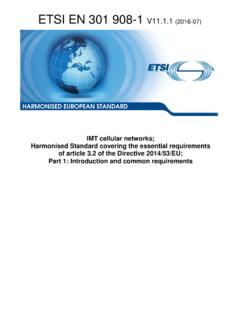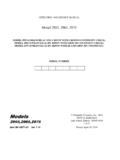Transcription of EN 301 489-6 - V1.3.1 - Electromagnetic compatibility and ...
1 ETSI EN 301 489-6 (2008-08)Harmonized European Standard (Telecommunications series) Electromagnetic compatibilityand Radio spectrum Matters (ERM); Electromagnetic compatibility (EMC)standard for radio equipment and services;Part 6: Specific conditions for Digital Enhanced CordlessTelecommunications (DECT) equipment ETSI ETSI EN 301 489-6 (2008-08) 2 Reference REN/ERM-EMC-265-6 Keywords DECT, EMC, radio, regulation ETSI 650 Route des Lucioles F-06921 Sophia Antipolis Cedex - FRANCE Tel.: +33 4 92 94 42 00 Fax: +33 4 93 65 47 16 Siret N 348 623 562 00017 - NAF 742 C Association but non lucratif enregistr e la Sous-Pr fecture de Grasse (06) N 7803/88 Important notice Individual copies of the present document can be downloaded from: The present document may be made available in more than one electronic version or in print.
2 In any case of existing or perceived difference in contents between such versions, the reference version is the Portable Document Format (PDF). In case of dispute, the reference shall be the printing on ETSI printers of the PDF version kept on a specific network drive within ETSI Secretariat. Users of the present document should be aware that the document may be subject to revision or change of status. Information on the current status of this and other ETSI documents is available at If you find errors in the present document, please send your comment to one of the following services: Copyright Notification No part may be reproduced except as authorized by written permission. The copyright and the foregoing restriction extend to reproduction in all media. European Telecommunications Standards Institute 2008. All rights reserved.
3 DECTTM, PLUGTESTSTM, UMTSTM, TIPHONTM, the TIPHON logo and the ETSI logo are Trade Marks of ETSI registered for the benefit of its Members. 3 GPPTM is a Trade Mark of ETSI registered for the benefit of its Members and of the 3 GPP Organizational Partners. ETSI ETSI EN 301 489-6 (2008-08) 3 Contents Intellectual Property Rights ..5 1 Scope ..6 2 References ..6 Normative references ..6 Informative 3 Definitions and Definitions ..7 Abbreviations ..7 4 Test conditions ..8 General ..8 Arrangements for test signals ..8 Arrangements for test signals at the input of Speech equipment ..8 Non-speech Arrangements for test signals at the output of Arrangements for test signals at the input of receivers.
4 8 Arrangements for test signals at the output of receivers ..8 Arrangements for testing transmitter and receiver together (as a system) ..9 Exclusion Narrow band responses on receivers or receivers which are part of Normal test modulation ..9 5 Performance General ..10 Arrangements for the assessment of host dependant equipment and plug-in Alternative A: composite equipment ..10 Alternative B: use of a test jig and three Assessment Loss of user control functions or stored user defined Audio breakthrough ..11 Ancillary equipment ..12 Equipment classification ..12 6 Performance criteria ..12 General.
5 12 Performance criteria for Continuous phenomena of Transceivers (CT)..13 Performance criteria for Transient phenomena applied to Transceivers (TT)..13 Performance criteria for Continuous phenomena applied to Receive-only equipment (CR) ..13 Performance criteria for Transient phenomena applied to Receive-only equipment (TR) ..14 Performance criteria for ancillary equipment tested on a stand alone basis ..14 7 Applicability overview ..14 Emission ..14 Special conditions ..14 Immunity ..14 Special conditions ..14 Annex A (normative): Definitions of cordless telecommunications equipment in the scope of the present Digital Enhanced Cordless Telecommunications (DECT) Annex B (informative): The EN title in the official languages.
6 16 ETSI ETSI EN 301 489-6 (2008-08) 4 Annex C (informative): Bibliography ..17 History ..18 ETSI ETSI EN 301 489-6 (2008-08) 5 Intellectual Property Rights IPRs essential or potentially essential to the present document may have been declared to ETSI. The information pertaining to these essential IPRs, if any, is publicly available for ETSI members and non-members, and can be found in ETSI SR 000 314: "Intellectual Property Rights (IPRs); Essential, or potentially Essential, IPRs notified to ETSI in respect of ETSI standards", which is available from the ETSI Secretariat. Latest updates are available on the ETSI Web server ( ). Pursuant to the ETSI IPR Policy, no investigation, including IPR searches, has been carried out by ETSI. No guarantee can be given as to the existence of other IPRs not referenced in ETSI SR 000 314 (or the updates on the ETSI Web server) which are, or may be, or may become, essential to the present document.
7 Foreword This Harmonized European Standard (Telecommunications series) has been produced by ETSI Technical Committee Electromagnetic compatibility and Radio spectrum Matters (ERM). The present document has been produced by ETSI in response to a mandate from the European Commission issued under Council Directive 98/34/EC [ ] (as amended) laying down a procedure for the provision of information in the field of technical standards and regulations. The present document is intended to become a Harmonized Standard, the reference of which will be published in the Official Journal of the European Communities referencing the Directive 1999/5/EC [ ] of the European Parliament and of the Council of 9 March 1999 on radio equipment and telecommunications terminal equipment and the mutual recognition of their conformity ("the R&TTE Directive") [ ]).
8 The present document is part 6 of a multi-part deliverable. Full details of the entire series can be found in part 1 [1]. National transposition dates Date of adoption of this EN: 8 August 2008 Date of latest announcement of this EN (doa): 30 November 2008 Date of latest publication of new National Standard or endorsement of this EN (dop/e): 31 May 2009 Date of withdrawal of any conflicting National Standard (dow): 31 May 2010 ETSI ETSI EN 301 489-6 (2008-08) 6 1 Scope The present document, together with EN 301 489-1 [1], covers the assessment of Digital Enhanced Cordless Telecommunications (DECT) equipment, and associated ancillary equipment, in respect of Electromagnetic compatibility (EMC). Technical specifications related to the antenna port and emissions from the enclosure port of the radio equipment are not included in the present document.
9 Such technical specifications are found in the relevant product standards for the effective use of the radio spectrum. The present document specifies the applicable test conditions, performance assessment and performance criteria for Digital Enhanced Cordless Telecommunications (DECT) equipment, and associated ancillary equipment. Definitions of types of cordless telecommunications equipment covered by the present document are given in annex A. In case of differences (for instance concerning special conditions, definitions, abbreviations) between the present document and EN 301 489-1 [1], the provisions of the present document take precedence. The environmental classification and the emission and immunity requirements used in the present document are as stated in EN 301 489-1 [1], except for any special conditions included in the present document.
10 2 References References are either specific (identified by date of publication and/or edition number or version number) or non-specific. For a specific reference, subsequent revisions do not apply. Non-specific reference may be made only to a complete document or a part thereof and only in the following cases: - if it is accepted that it will be possible to use all future changes of the referenced document for the purposes of the referring document; - for informative references. Referenced documents which are not found to be publicly available in the expected location might be found at For online referenced documents, information sufficient to identify and locate the source shall be provided. Preferably, the primary source of the referenced document should be cited, in order to ensure traceability. Furthermore, the reference should, as far as possible, remain valid for the expected life of the document.
